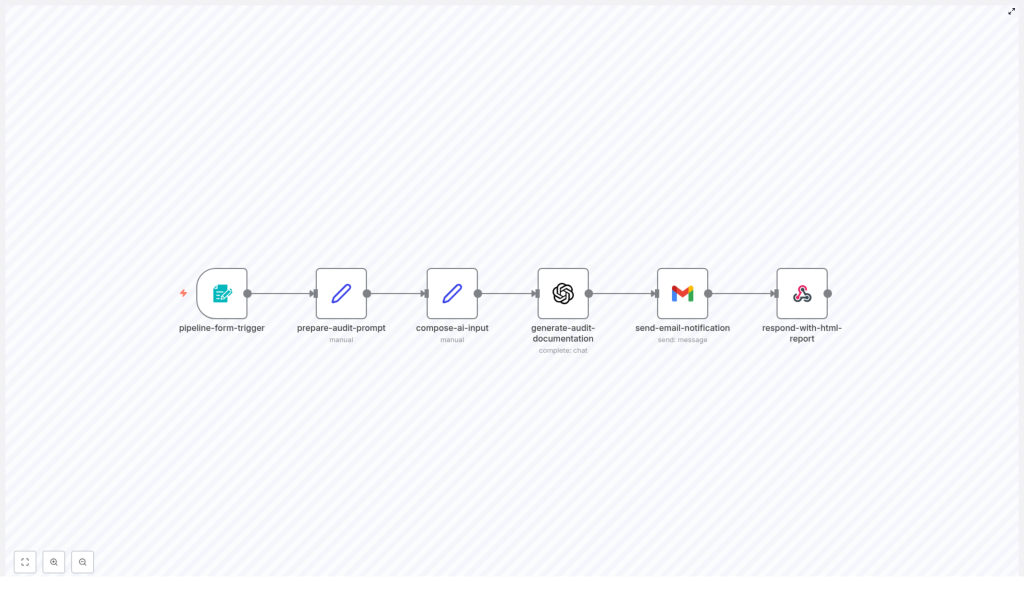n8n CI/CD Pipeline Auditor Workflow Guide
Use this guide to understand, deploy, and customize an n8n workflow that audits CI/CD pipeline configuration files with OpenAI and delivers polished HTML and email reports.
Overview
This tutorial breaks down a ready-made n8n workflow—named CI/CD Pipeline Auditor—that accepts pipeline files via a form, uses an OpenAI model to generate a concise audit and documentation, emails the results, and returns an HTML report. The workflow automates pipeline audits for teams that want consistent, actionable reviews of YAML/Jenkinsfiles/Azure Pipelines configurations.
Why this workflow matters
- Standardizes configuration reviews across teams
- Turns raw pipeline files into human-readable audit reports
- Saves time with automated email delivery and formatted HTML output
- Integrates OpenAI for concise, actionable recommendations
Workflow diagram — high level
The workflow follows a linear flow of nodes inside n8n. From left to right:
- Form Trigger — collects pipeline name, file, notification email, and pipeline type
- Set (prepare prompt) — builds an audit prompt with guidelines and examples
- Set (compose AI input) — formats the combined payload for the OpenAI node
- OpenAI (generate audit) — creates the audit documentation
- Gmail (send email) — emails the audit report as HTML to stakeholders
- Respond to Webhook — returns a polished HTML report in the form response
How it works — node-by-node
1. pipeline-form-trigger
This node exposes a webhook form. Typical fields include:
- Pipeline Name (text)
- Pipeline File (textarea) — paste YAML/Jenkinsfile content
- Notification Email (email)
- Pipeline Type (dropdown) — GitHub Actions, GitLab CI, Jenkinsfile, Azure Pipelines, Other
Use this node to let engineers submit pipeline files for on-demand auditing without needing CLI tools or repo access.
2. prepare-audit-prompt
This Set node contains a thoughtfully constructed prompt template that instructs the OpenAI model how to produce a concise, actionable audit. The prompt includes sections to produce:
- Who the pipeline is for
- Use case and problems solved
- Pipeline overview (triggers, jobs/stages, env vars, images)
- Expected outcomes
- Setup, rollout, and customization tips
- Security and compliance notes
3. compose-ai-input
Combines form inputs and the prompt into a single string payload that gets sent to the OpenAI node. It helps ensure the model receives both the raw pipeline config and explicit instructions for formatting the audit.
4. generate-audit-documentation (OpenAI)
Using an OpenAI Chat model (the workflow example uses a GPT-4 class model), this node generates the final audit text. Recommended settings in the template are a moderate temperature (e.g., 0.7) and a generous token limit to allow for detailed output.
5. send-email-notification
This Gmail node sends an HTML email to the notification address provided in the form. The message body contains the formatted audit and a summary header. Configure OAuth2/Gmail credentials in n8n before enabling this node.
6. respond-with-html-report
Finally, the workflow returns a beautiful HTML report to the form submitter (or browser) using the Respond to Webhook node. The template applies simple styling, a success badge, and the audit content formatted for readability.
Setup & prerequisites
Before you run the workflow, prepare the following:
- n8n instance (cloud or self-hosted) with internet access
- OpenAI API key added to n8n credentials
- Gmail OAuth2 credentials (or swap to SMTP/SendGrid if you prefer)
- Optional: secure hosting for the webhook if you want external access
Installation steps
- Import the workflow JSON into n8n.
- Open the Form Trigger node and set its webhook path and form fields as needed.
- Attach your OpenAI credential to the OpenAI node and set the model, temperature, and max tokens.
- Configure the Gmail node with OAuth2 details, or replace it with your email provider.
- Activate the workflow and test by submitting the form with a sample pipeline file.
Customization ideas
This template is intentionally modular — you can extend it for your organization:
- Add a code scanner to automatically run linters or static analysis (e.g., yamllint, hadolint).
- Integrate a secrets scanner (e.g., GitGuardian) before sending content to OpenAI.
- Persist audits to a database (MySQL/Postgres) or a ticketing system like Jira for traceability.
- Send results to Slack, MS Teams, or a GitHub PR comment instead of email.
- Use role-based access controls and an approval step for production pipeline changes.
Security & compliance
When passing pipeline configuration to a third-party model, consider these best practices:
- Mask or remove secrets (API keys, passwords) before sending content to OpenAI.
- Limit exposure of private repo details — fetch config files server-side if possible instead of pasting secrets into a form.
- Use organizational OpenAI access controls and data usage policies if available.
- Log who requested an audit and keep a retention policy for audit data.
Best practices & tips
- Design the OpenAI prompt to be explicit about output structure to ensure consistently formatted audits.
- Keep the model focused on actionable steps — prefer brevity and clarity over long-winded analysis.
- Use the pipeline type dropdown to give the model context (e.g., GitHub Actions vs. Jenkinsfile).
- Run an initial validation pass on the pipeline YAML to catch syntax issues before generation.
- Consider adding a severity score or checklist (pass/fail) for fast triage.
Example output structure
The OpenAI prompt in this workflow requests a structured audit. Example sections you will receive:
# Who is this pipeline for?
# What problem does this pipeline solve?
# Pipeline Overview
- Triggers
- Jobs/Stages
- Key steps
- Environment variables
# Expected Outcomes
# Setup & Rollout Instructions
# How to customize
# Security & Compliance Considerations

